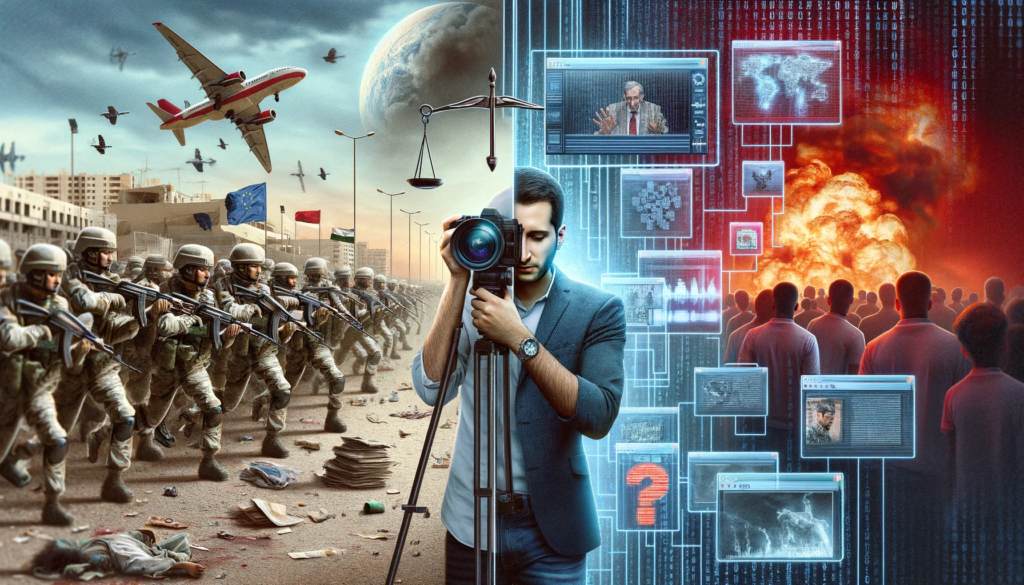Unveiling the Digital Illusion: The Critical Role of Generative AI in Modern Conflict Journalism

Exploring the Complex Role of Generative AI in Modern Conflict Reporting.
- What is the role of Generative AI in modern conflict journalism?
- How does Generative AI create challenges in conflict reporting, especially in scenarios like the Israel-Hamas conflict?
- What are the ethical implications of using Generative AI to create or spread content, particularly false information?
- How does Generative AI impact public perception and the dissemination of misinformation in conflict situations?
- What challenges do journalists and fact-checkers face in the era of Generative AI?
- What are the necessary regulatory measures and policies to mitigate the misuse of Generative AI?
- How can awareness about Generative AI’s capabilities and risks be enhanced among the public and professionals?
In the ever-evolving landscape of technology, Generative Artificial Intelligence (GAI) marks a significant leap forward. This advanced form of AI, known for its ability to generate new content, has rapidly gained prominence, revolutionizing various sectors with its innovative capabilities. One such area where GAI’s impact is increasingly evident is in the realm of conflict reporting. This article delves into the specific application of GAI in the context of reporting on high-tension scenarios, such as the Israel-Hamas conflict. By examining the role of GAI in this setting, we uncover the nuances of its influence on information dissemination and public perception during times of conflict.
Deep Fakes in the Israeli-Hamas Conflict: A Disturbing Trend in Information Warfare
In the digital age, the battleground extends beyond physical territories, infiltrating the realms of information and perception. A particularly alarming development in this arena is the use of deep fakes — sophisticated AI-generated videos or images that convincingly depict events or statements that never occurred. The Israeli-Hamas conflict, a complex and emotionally charged geopolitical situation, is not immune to this form of digital manipulation.
The potency of deep fakes lies in their ability to create alternate realities, blurring the lines between truth and fabrication. In the context of the Israeli-Hamas conflict, deep fakes could be weaponized to falsely portray actions or statements by key figures or to fabricate incidents that could inflame tensions or sway public opinion. The implications are profound: a well-crafted deep fake could not only mislead viewers but also potentially trigger real-world responses based on false information.
For instance, imagine a deep fake video showing a leader from either side engaging in inflammatory rhetoric or admitting to covert operations that never occurred. Such content, if believed, could rapidly escalate tensions, incite violence, or undermine diplomatic efforts. The speed at which these fakes can circulate on social media further amplifies their impact, outpacing the ability of fact-checkers and AI detection tools to debunk them.
The ethical implications are clear: using deep fakes in such a sensitive and volatile context is not just a matter of misinformation but a direct threat to peace and stability. It raises critical questions about accountability and the moral responsibility of those who create and disseminate such content.
To combat this threat, there’s an urgent need for advanced detection methods and stringent regulatory frameworks. Media literacy campaigns are equally essential, equipping the public to critically evaluate the authenticity of information they encounter. The Israeli-Hamas conflict, already mired in complexities, serves as a stark reminder of the dire consequences when generative AI is misused, underscoring the need for ethical guidelines and vigilant regulation in the age of AI-enhanced information warfare.
The Double-Edged Sword of GAI in Conflict Reporting
Generative AI has emerged as a powerful tool in conflict reporting, but it brings with it a paradoxical blend of benefits and risks. On one hand, GAI’s advanced algorithms can create highly realistic and compelling narratives or images that can enhance the understanding of conflict situations. However, this same capability opens the door to the creation of false narratives and misleading imagery.
For instance, in scenarios resembling the Israel-Hamas conflict, GAI could be employed to generate convincing but entirely fabricated visual content or narratives. These could range from altered images of battlegrounds to synthetic interviews with ‘eyewitnesses’ that never existed. Such misrepresentations, crafted with a high degree of realism, have the potential to skew public opinion, manipulate emotional responses, and even influence diplomatic decisions.
The risk is not just theoretical. There have been instances in various global conflicts where digital misinformation has played a role, though the specific use of GAI in these cases might be less clear-cut. This ambiguity itself is telling – the seamless integration of GAI-generated content into the media ecosystem makes it increasingly difficult to discern what is real and what is artificially constructed.
This complex landscape necessitates a critical approach to conflict reporting in the age of GAI. It calls for enhanced media literacy among the public and stricter verification protocols within news organizations. The goal is to harness GAI’s potential for insightful, accurate reporting while guarding against its ability to fabricate and mislead.
The Challenge for Fact-Checkers and Journalists
In the era of GAI, fact-checkers and journalists face an unprecedented challenge. The advent of GAI has significantly complicated their roles, demanding not only traditional skills in verifying information but also a nuanced understanding of artificial intelligence.
For fact-checkers, the emergence of GAI means grappling with content that is increasingly difficult to authenticate. Unlike traditional forms of misinformation, GAI-generated content can be more sophisticated and harder to detect. This has led to a growing need for fact-checkers to be equipped with advanced tools and training in digital forensics and AI analytics.
Journalists, on the other hand, are confronting a landscape where the line between reality and AI-generated content is blurrier than ever. The ability to discern and report the truth in this environment is more critical than ever. Interviews with seasoned journalists reveal a sense of urgency in adapting to this new reality. They emphasize the importance of staying updated with the latest in AI developments and collaborating closely with tech experts to maintain the integrity of their reporting.
The experiences shared by these professionals highlight a common theme: the need for a combined approach that integrates traditional journalistic rigor with a deep understanding of AI technologies. This includes adopting new verification methodologies, continuous learning, and staying ahead of the evolving GAI trends.
This heightened challenge also underscores the need for broader institutional support. News organizations and fact-checking agencies must invest in resources and training to equip their teams with the necessary skills and tools to navigate the complex terrain of GAI-influenced media.
The rise of GAI represents a watershed moment for fact-checkers and journalists. It calls for a recalibration of their roles, where adaptability, technological proficiency, and a commitment to journalistic integrity become the cornerstones of their profession in the digital age.
Public Perception and the Power of Misinformation
The influence of GAI on public perception, particularly in conflict scenarios, is profound and multifaceted. GAI-generated content has the potential to significantly shape public understanding and opinions about conflicts, often in ways that are not immediately apparent.
Firstly, the psychological impact of misinformation in such contexts cannot be overstated. When individuals are exposed to realistic but fabricated narratives or images created by GAI, it can lead to a skewed perception of reality. This misinformation can reinforce biases, stir up emotional responses, and even influence public opinion on critical matters. The plausibility of GAI content makes it particularly insidious, as it becomes challenging for the average person to discern fact from fiction.
From a societal perspective, the spread of misinformation through GAI can have far-reaching consequences. It can exacerbate tensions, fuel unrest, or incorrectly sway public sentiment during crucial moments such as elections or social movements. In conflict zones, this can lead to escalated hostilities or hinder peace efforts by spreading false narratives about the parties involved.
Moreover, the ease with which GAI can generate convincing misinformation creates a fertile ground for propaganda and manipulation. State actors or interest groups can potentially exploit this technology to advance specific agendas, misleading the public and international observers.
Addressing these challenges requires a concerted effort from various stakeholders. This includes enhancing public awareness about GAI technologies, developing more robust methods to identify and counteract AI-generated misinformation, and promoting media literacy to empower individuals to critically assess the information they encounter.
In conclusion, while GAI offers groundbreaking possibilities, its ability to influence public perception and spread misinformation, especially in the context of conflict, necessitates a vigilant and proactive approach to safeguard the integrity of information and the societal fabric.
Ethical Implications and Responsibilities
The ethical landscape surrounding the use of Generative AI in creating or spreading content, especially false information, is intricate and demands careful navigation. One of the primary ethical concerns is the potential misuse of GAI to fabricate convincing yet false narratives or images, which could have serious consequences in various realms, including politics, journalism, and social discourse.
To address these concerns, there’s a growing call for establishing ethical guidelines or frameworks specifically tailored to GAI usage, particularly in sensitive contexts. These guidelines would emphasize accountability, transparency, and responsibility in the deployment of GAI technologies. They could include measures such as mandatory disclosure when GAI is used to create content, strict regulations against using GAI for deceptive purposes, and guidelines for fact-checking and verification processes to mitigate the spread of misinformation.
Furthermore, there’s an ethical imperative for developers and users of GAI technologies to consider the broader social impact of their creations. This includes a responsibility to prevent the technology’s exploitation for harmful purposes, such as inciting violence, spreading falsehoods in conflict scenarios, or manipulating public opinion.
The development of such ethical frameworks would involve collaboration among technologists, ethicists, policymakers, and other stakeholders. The goal would be to harness the potential of GAI for positive applications while safeguarding against its risks, ensuring that its deployment is aligned with societal values and ethical principles.
In conclusion, while GAI presents exciting possibilities, it is imperative to embed ethical considerations at the core of its development and application. By proactively establishing robust ethical guidelines, we can better navigate the challenges posed by this powerful technology and ensure its use benefits society.
The Road Ahead: Awareness and Regulation
As we chart the future course in the era of Generative AI, a pivotal aspect is enhancing public and professional awareness about its capabilities and inherent risks. This heightened awareness is crucial in building a society that is both informed and cautious about the potential misuse of GAI technologies, especially in sensitive areas like conflict reporting.
Simultaneously, the development and implementation of regulatory measures and policies are essential to mitigate the risks of GAI misuse. This calls for a multifaceted approach involving government bodies, technology developers, academia, and civil society to collaboratively establish a regulatory framework. Such a framework would not only set boundaries for the ethical use of GAI but also foster an environment where innovation can thrive within those boundaries.
These regulations could range from strict guidelines on the use of GAI in media and information dissemination to policies ensuring transparency and accountability in AI-generated content. Additionally, there could be a focus on safeguarding data privacy and security, preventing identity theft or unauthorized use of personal data in GAI applications.
In essence, the road ahead demands a balanced approach, where awareness and regulation work hand in hand. By creating an informed public, encouraging responsible innovation, and implementing effective policies, we can ensure that GAI serves as a tool for progress rather than a source of misinformation or harm. This proactive stance will be pivotal in harnessing the full potential of GAI while safeguarding our social and ethical values.
Conclusion
As we stand at the precipice of a new era shaped by Generative AI, it’s imperative to reflect on the multifaceted impact of this technology in journalism and public discourse. This article has highlighted the double-edged sword GAI represents in conflict reporting, the challenges it poses for fact-checkers and journalists, its profound effect on public perception and misinformation, the pressing ethical concerns, and the necessity for awareness and regulation.
Looking ahead, the role of GAI in shaping narratives and influencing opinions is undeniable. It’s crucial that its deployment in sensitive areas like journalism is guided by ethical considerations and vigilant regulation. The future of GAI in journalism hinges on striking a delicate balance between harnessing its innovative potential and safeguarding the integrity of information. As this technology continues to evolve, it is the collective responsibility of creators, users, and regulators to ensure that GAI serves the truth and public interest, rather than undermining them. This journey is not just about technological advancement; it’s about preserving the core values of accurate reporting and responsible public discourse in our increasingly digital world.




